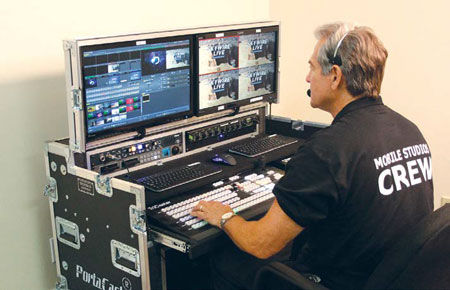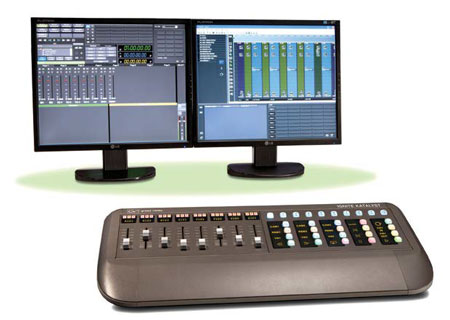Integrated Production Systems Go IP
HAMILTON, N.J.—Integrated production systems offer an easy and affordable way for virtually anyone to produce multicamera HD show and even stream live to online viewers.
Since they pack the functionality of a control room—such as multicamera switching, robotic camera control, keying, effects, audio mixing, CG, multiviewers, virtual sets, video playout, encoding and streaming— into a compact, user-friendly system that one person can operate, they’ve taken hold in non-traditional video settings like education, corporate and worship.
INTEGRATING THIRD-PARTY TECHNOLOGY
With powerful new features—like automatic camera switching, IP-driven workflows and seamless integration with Skype and cloud storage—these systems are starting to make inroads in the broadcast space.
One reason that adoption by broadcasters has been slow is that—with end-to-end functionality in one box—they haven’t been able to integrate best-in-class third-party products the way they’ve always done in video control rooms.

Discovery Channel uses Mobile Studios PortaCast HD flypack consoles. But with the introduction of NDI (Network Device Interface) by NewTek at the 2015 IBC Show, third-party integration is now possible with some integrated production systems. NewTek, which offers its flagship TriCaster and other integrated production systems, offers the license for free to any developer who downloads the SDK to make their products NDI-capable.
In doing so, any NDI-enabled device can now see any other NDI-enabled devices that are plugged into a standard Gig-E network, such as graphics systems, replay devices, storage devices, laptops, switchers and cameras. Switchers can select any of these sources as part of a multicamera production. A TriCaster, for example, will be able to choose sources between physically connected cameras and/or other video sources available over IP on a local area network. Companies ranging from AJA and Blackmagic Design to Matrox and Chyron-Hego have announced compatibility with the protocol.
“NDI is bidirectional, so all NDI-enabled sources on the same LAN are equal,” said Scott Carroll, director of public relations for the San Antonio-based company. “They can see and be seen to create interoperability between third-party systems and connect via a single Ethernet cable. Whether they’re next door or miles away, it’s frame-accurate, with less than a frame of latency.
Get the TV Tech Newsletter
The professional video industry's #1 source for news, trends and product and tech information. Sign up below.
NDI also lets production facilities maximize their SDI investments, such as broadcast cameras, while migrating to an IP workflow, according to Carroll. “We believe that IP workflows are the future of multicamera video production, and with NDI, we’re enabling that reality sooner rather than later.”
INTEROPERABILITY
Australian vendor, vMix, integrates NDI into its 4 and 8 input Go integrated production system. The Go enables switching, processing, recording and streaming of up to 4K-video. This turnkey system integrates built-in graphics, replay, text, DVR, and virtual sets, in a case small enough to fit in the overhead storage on a plane.
“NDI is an open technology that’s leveling the playing field for all of us,” said Eric Pratt, Sales Engineer for US Broadcast, which is the North American Distributor for vMix. “It’s making life easier by enabling interoperability without occupying an I/O connector.”
“Having a single operator control the entire production may not be best for every production,” Pratt says, “NDI lets our users break out various vMix functions, like replay, titling, and graphics, and put them on separate laptops so other operators can run them.”
“Then their graphics, replays or titles show up automatically as a source,” Pratt added. “You don’t have to be using a NewTek device to make this work, any NDI compatible product will integrate. A lot of companies are jumping on the bandwagon, and I expect big buzz about it at NAB.”
OFFERING A CHOICE
James Gilbert, CEO of Pixel Power, points out that integrated production systems limit customers to buying just the tools that have been built-in, so they’re locked in to buying everything from a single vendor.
“If you don’t like the graphics tools that have been built in to the integrated production system, it’s hard to swap that out for something you like more,” Gilbert said. “Broadcasters are used to choosing best-of-breed systems, but if you go down this integrated path, if something isn’t working well for you, you need to make sure there are hooks that allow you to substitute something else into your workflow.”
Offering choices to integrated production users is a key part of Pixel Power’s strategy, according to Gilbert. “We’re making our core graphics technology available as a plug-in that can work within integrated production systems,” he said.
Graphics, including live, multilayered 3D and channel branding, has been Pixel Power’s core competence for nearly 30 years. Its latest software products, Pixel Factory and StreamMaster are suitable for IP file-based workflows. Pixel Factory, which delivers the impact of Clarity, is software that runs on standard IT servers in file-based workflows. StreamMaster, which is integrated playout software with graphics and branding capabilities, can be virtualized on servers at data centers or in the cloud.

Grass Valley Ignite is a software-based integrated production system that allows a single operator to manage a control room full of devices for live newscasts and event programming.REMOTE CONTROL OVER IP
At Broadcast Pix, Product Manager Tony Mastantuono says that operational and labor cost pressures are driving the higher end of the video business to take a closer look at their multiconfigurable Flint and other integrated production systems.
“As our systems get more powerful, economical, and compact, they’re realizing they no longer have to move a 50- foot trailer with a skilled multiperson crew for every event,” Mastantuono said. “They can leave Flint at their master control, and just send a small crew with a flypack to shoot the video and send it back live to the studio. Then Flint can be used to remotely control the production over an IP network, which is one of the ways it helps keep production costs down.”
With its multitiered IP approach, Flint also streams directly to the Internet while simultaneously recording, allows access to media and files from cloud services like Google Drive, Dropbox, and Microsoft One Drive, as well as the ability to incorporate Skype calls and PowerPoint presentations into live productions. The system also offers wireless control via a tablet.
Earlier this month, Broadcast Pix announced that it had joined the ASPEN Alliance, an IP-based protocol backed by Evertz.
VIDEO TO GO
With its PortaCast HD flypack consoles— which house components by such vendors as NewTek, Ross, Panasonic, For-A and Sony—Mobile Studios makes it easy for integrated production systems to be set up quickly.
“We’re seeing growing demand for our systems as people in many vertical markets—such as corporate and education—recognize the importance of producing and distributing their own video content,” said Rich Rubin, president of Mobile Studios, in Deerfield Beach, Fla. “In the age of IP video distribution, even small to mid-sized companies need to use video strategically to promote themselves and their products and services in order to stay relevant and competitive.”
PortaCast Deluxe features a hinged lid that supports multiview monitors, a pullout drawer that provides a switching control surface, a bench that doubles as storage for cables, and built-in storage for up to 22 rack units of components.
The waterproof, shockmounted case can be wheeled over steps or into a van using an optional aluminum PortaRamp for easy transport.
NEW OPPORTUNITIES
Integrated production systems are breaking down barriers and allowing talented video producers—regardless of budget—to enter the live production market, according to Rush Beesley, president of RUSHWORKS, in Dallas.
“When you factor in affordable cameras, lightweight LED lighting panels, green-screen and channel-in-a-box playout, you now have much of what you need to run a robust, 24/7 TV channel for under $75K,” he said.
RUSHWORKS offers VDESK multicamera pan/tilt/zoom (PTZ) production systems with 4, 8 or 12 SDI/analog inputs starting at $7,500. It also offers control of most PTZ cameras, HD/SD production and streaming, remote control using a tablet over a wireless network, and Talk- Take automated video switching intelligence based on active microphone detection.
RUSHWORKS is integrating the Blackmagic Design Micro Studio 4K camera with its next generation PTX pan & tilt head. The solution will be on display at the NAB Show, controlled by VDESK and also by a DMX lighting console.
SOFTWARE-BASED
Continuing the trend towards crew consolidation, Grass Valley Ignite is a software- based integrated production system that allows a single operator to manage a control room full of devices for live newscasts and event programming. When Ignite automation is paired with the GV Stratus Digital Media Platform (DMP), broadcasters have an integrated production workflow for distributing content efficiently across multiple platforms, such as TV, Web and mobile.
“DMP automates the newscast beyond traditional on-air TV, and eliminates the need for human intervention to prepare complex, ad-supported content for multiplatform delivery,” said Ed Casaccia, senior director of product management/digital media and workflows for Grass Valley in Montreal.
“When a news story airs during a live newscast, it may consist of many elements, such as an on-camera intro, field report, Broll with a voice-over, graphics and an on-camera wrap-up,” Casaccia added. “DMP marks the in and out points of that entire news report, treats all of those components as a single segment, and then automates its delivery to the Web and mobile.”
There are also additional processing capabilities, such as the ability to replace embargoed content, like a few seconds of sports action with a suitable alternative, such as a scoreboard graphic. It’s also possible to dynamically insert different ads into the online versions, and even “hyper-localize” the ads based on zip codes or other criteria.

